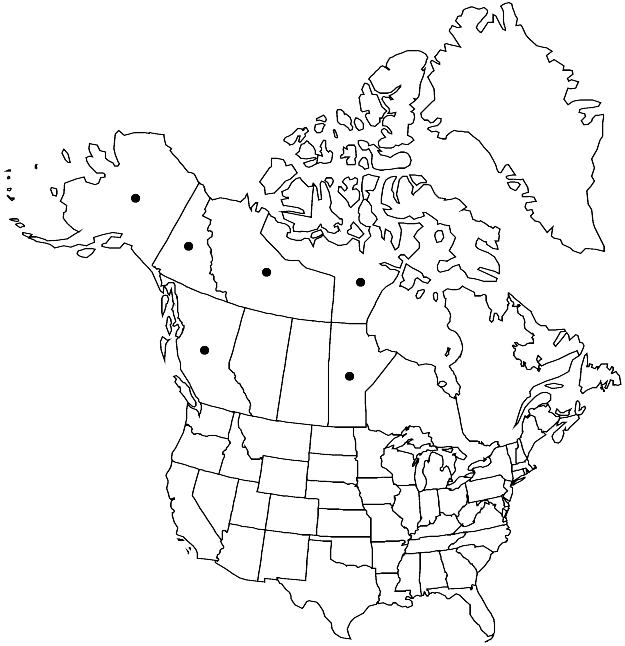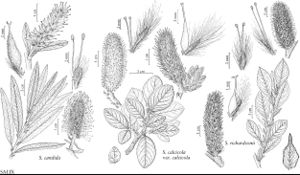Difference between revisions of "Salix richardsonii"
Fl. Bor.-Amer. 2: 147, plate 182. 1838.
FNA>Volume Importer |
imported>Volume Importer |
||
| (5 intermediate revisions by 2 users not shown) | |||
| Line 8: | Line 8: | ||
}} | }} | ||
|common_names=Richardson’s willow | |common_names=Richardson’s willow | ||
| + | |special_status={{Treatment/ID/Special_status | ||
| + | |code=F | ||
| + | |label=Illustrated | ||
| + | }} | ||
|basionyms= | |basionyms= | ||
|synonyms={{Treatment/ID/Synonym | |synonyms={{Treatment/ID/Synonym | ||
|name=Salix lanata subsp. richardsonii | |name=Salix lanata subsp. richardsonii | ||
|authority=(Hooker) A. K. Skvortsov | |authority=(Hooker) A. K. Skvortsov | ||
| + | |rank=subspecies | ||
}} {{Treatment/ID/Synonym | }} {{Treatment/ID/Synonym | ||
|name=Salix richardsonii var. mckeandii | |name=Salix richardsonii var. mckeandii | ||
|authority=Polunin | |authority=Polunin | ||
| + | |rank=variety | ||
}} | }} | ||
|hierarchy=Salicaceae;Salix;Salix subg. Vetrix;Salix sect. Lanatae;Salix richardsonii | |hierarchy=Salicaceae;Salix;Salix subg. Vetrix;Salix sect. Lanatae;Salix richardsonii | ||
| Line 40: | Line 46: | ||
-->{{#Taxon: | -->{{#Taxon: | ||
name=Salix richardsonii | name=Salix richardsonii | ||
| − | |||
|authority=Hooker | |authority=Hooker | ||
|rank=species | |rank=species | ||
| Line 54: | Line 59: | ||
|publication title=Fl. Bor.-Amer. | |publication title=Fl. Bor.-Amer. | ||
|publication year=1838 | |publication year=1838 | ||
| − | |special status= | + | |special status=Illustrated |
| − | |source xml=https:// | + | |source xml=https://bitbucket.org/aafc-mbb/fna-data-curation/src/2e0870ddd59836b60bcf96646a41e87ea5a5943a/coarse_grained_fna_xml/V7/V7_160.xml |
|genus=Salix | |genus=Salix | ||
|subgenus=Salix subg. Vetrix | |subgenus=Salix subg. Vetrix | ||
Latest revision as of 22:31, 5 November 2020
Plants 0.3–6.5 m. Stems: branches red-brown, yellow-brown, or violet, not to strongly glaucous (slightly or highly glossy), villous to glabrescent with persistent patches of hairs; branchlets red-brown or yellow-brown, pilose to densely villous, (buds caprea-type, scale inner membrane free, separating from outer layer). Leaves: stipules (sometimes marcescent), foliaceous, (3–12–35 mm, 1.7–3.6–6.6 times as long as wide, lanceolate or narrowly elliptic, sometimes ovate or oval, base broad, abruptly tapering), apex acuminate or acute; petiole convex to flat or shallowly grooved adaxially, 2–7.3–27 mm, villous to glabrescent adaxially; largest medial blade broadly to narrowly elliptic, or obovate, 23–45–100 × 10–22–55 mm, 1.2–2.2–4.2 times as long as wide, base cuneate, convex, or concave, margins slightly revolute or flat, entire or serrulate, apex acute, acuminate, or convex, abaxial surface glaucous, glabrous or pilose, hairs (white, sometimes also ferruginous), curved, adaxial slightly glossy, moderately densely villous or pilose to glabrescent; proximal blade margins usually entire, sometimes serrulate; juvenile blade yellowish green, abaxially densely villous or pilose, sometimes glabrous, hairs white, sometimes also ferruginous. Catkins flowering before leaves emerge; staminate stout or subglobose, 22–53 × 16–24 mm, flowering branchlet 0 mm; pistillate densely flowered, slender or stout, 25–69(–85 in fruit) × 13–20 mm, flowering branchlet 0–2 mm; floral bract brown or black, 2.4–3.2 mm, apex acute, rounded, or retuse, abaxially moderately densely hairy, hairs straight. Staminate flowers: adaxial nectary narrowly oblong to oblong, 0.7–1.8 mm; filaments distinct to connate ca. 1/2 their lengths, glabrous; anthers purple turning yellow, ellipsoid to shortly cylindrical, 0.5–0.8 mm. Pistillate flowers: adaxial nectary narrowly oblong, oblong, or flask-shaped, 0.6–1.4 mm (2+-lobed), longer than stipe; stipe 0.4–1 mm; ovary pyriform, beak gradually tapering to styles; ovules 22–37 per ovary; styles 1–2.8 mm; stigmas slenderly cylindrical, 0.32–0.63–0.86 mm. Capsules 4.5–6.8 mm. 2n = 38.
Phenology: Flowering late May-early Jul.
Habitat: Arctic, subarctic, subalpine and boreal, stream terraces and floodplains, open forests, wet sedge meadows, fens, drumlin fields, gravel ridges, bogs, cliff ledges, snowbeds, silt, sand and gravel, calcareous or igneous substrates
Elevation: 10-1800 m
Distribution

B.C., Man., N.W.T., Nunavut, Yukon, Alaska, e Asia (Chukotka, Kamchatka, Russia [Anadyr], e Siberia).
Discussion
Hybrids:
Salix richardsonii forms natural hybrids with S. barclayi and S. calcicola.
Selected References
None.
